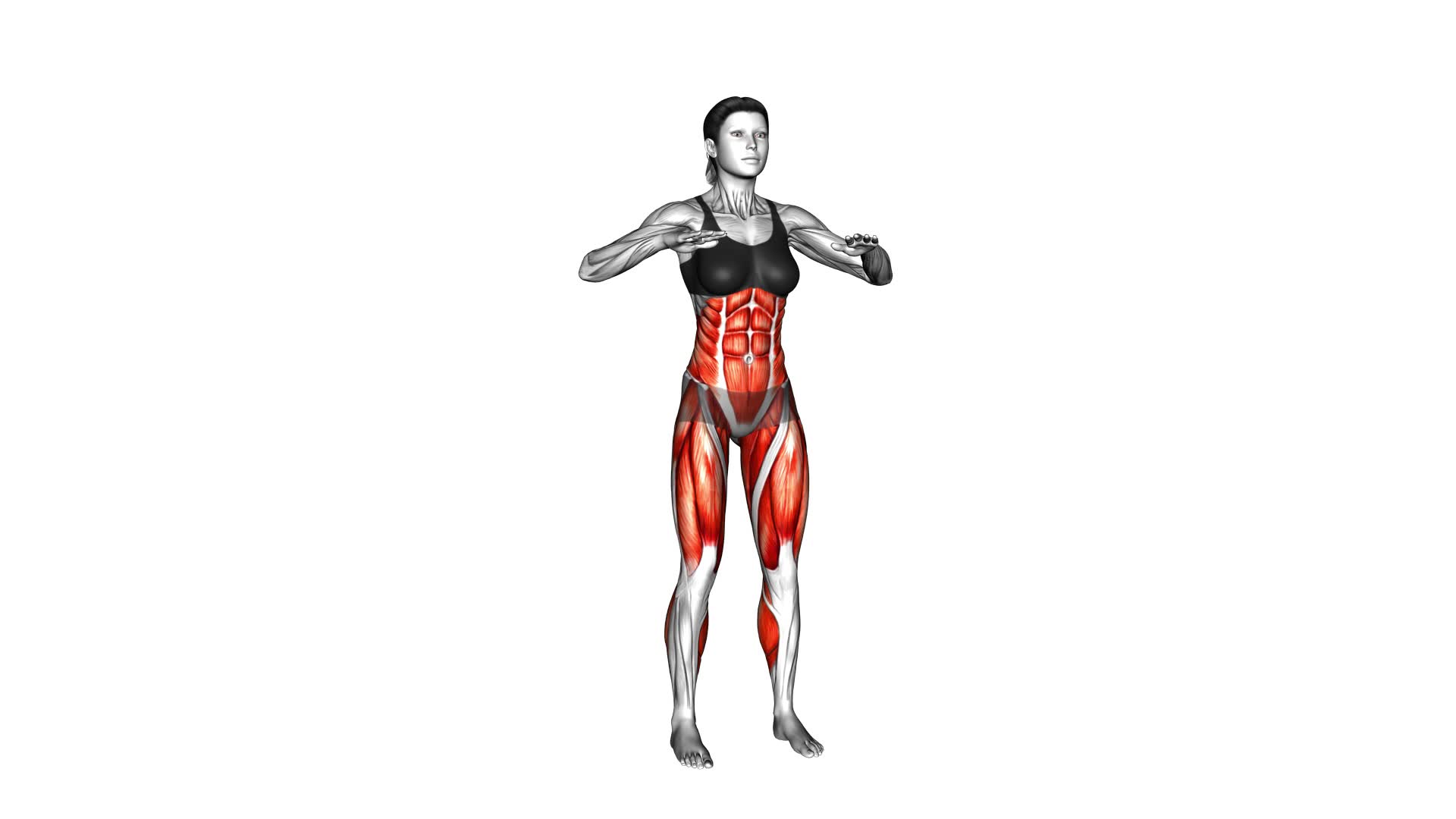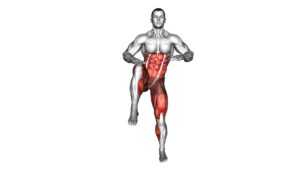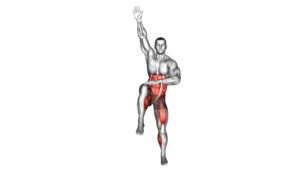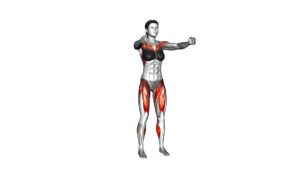High Knee Tap (female) – Video Exercise Guide & Tips

Get ready to tone your legs and boost your cardio with the high knee tap exercise. In this video exercise guide, we'll show you the proper form and technique to maximize results.
Watch This Exercise Video
You'll also learn variations and modifications to suit your fitness level. Avoid common mistakes and follow our tips for a more effective workout.
So grab your workout gear and get ready to sweat with the high knee tap!
Key Takeaways
- High knee tap exercise increases cardiovascular endurance.
- It engages multiple muscle groups and strengthens lower body muscles.
- Proper form and technique are important to avoid strain on the lower back.
- Adding resistance and increasing speed can make the exercise more intense.
Benefits of High Knee Tap
You can gain several benefits from incorporating high knee tap exercises into your fitness routine. These exercises are great for maximizing intensity and can be easily modified to fit your fitness level and goals.
One of the main benefits of high knee tap exercises is their ability to increase cardiovascular endurance. By elevating your heart rate and engaging multiple muscle groups, these exercises help improve your stamina and overall cardiovascular health. Additionally, the high knee tap variations allow you to tailor the exercise to your fitness level. Whether you're a beginner or an advanced athlete, you can adjust the speed, height, and intensity of the knee taps to challenge yourself and continue making progress.
Another benefit of high knee tap exercises is their ability to strengthen your lower body muscles, including your quadriceps, hamstrings, and glutes. By repeatedly lifting your knees and tapping them with your hands, you engage these muscles and promote their growth and development. This not only improves your overall strength but also enhances your balance and stability.
Incorporating high knee tap exercises into your fitness routine can also help with calorie burning and weight loss. Due to their high intensity and full-body engagement, these exercises can help you burn a significant amount of calories in a short period of time. This, combined with a balanced diet, can support your weight loss goals and aid in maintaining a healthy body composition.
Proper Form and Technique
To ensure proper form and technique during high knee tap exercises, focus on maintaining a stable and balanced stance. Start by standing with your feet hip-width apart and engage your core muscles. This will help you maintain good posture throughout the exercise and prevent any unnecessary strain on your lower back.
One common mistake is lifting the knees too high, which can lead to a loss of balance and increase the risk of injury. Instead, aim to bring your knees up to a 90-degree angle, tapping your hands just below the knee.
Another important aspect of proper form is maintaining core stability. Your core muscles, including your abdominals and lower back, play a crucial role in stabilizing your body during the exercise. Engage your core by drawing your belly button in towards your spine and activating your deep abdominal muscles.
By focusing on maintaining a stable and balanced stance, avoiding lifting the knees too high, and engaging your core stability, you'll be able to perform high knee tap exercises with proper form and technique. This will help maximize the benefits of the exercise and reduce the risk of injury.
Now that you understand the proper form and technique for high knee tap exercises, let's explore some variations and modifications that can add variety to your workout routine.
Variations and Modifications
Explore different ways to vary and modify the high knee tap exercise for added challenge and variety in your workout routine. By incorporating progression options and focusing on injury prevention, you can continue to challenge yourself while ensuring your safety.
One way to progress the high knee tap exercise is by adding resistance. You can do this by using ankle weights or holding dumbbells in your hands. This will increase the intensity and engage your muscles even more.
Another option is to increase the speed of your movements. By performing the exercise at a faster pace, you'll elevate your heart rate and improve your cardiovascular endurance.
To prevent injuries while performing the high knee tap exercise, it's important to maintain proper form and technique. Keep your core engaged and your back straight throughout the movement. Avoid leaning forward or sideways, as this can strain your lower back and hips. Additionally, be mindful of your knee alignment. Make sure your knees are tracking over your toes and not collapsing inward.
Remember to listen to your body and modify the exercise as needed. If you have any pre-existing injuries or limitations, consult with a qualified fitness professional for modifications that suit your needs.
Common Mistakes to Avoid
When performing the high knee tap exercise, it's important to avoid two common mistakes: incorrect knee alignment and lack of core stability.
To prevent incorrect knee alignment, make sure your knees are tracking over your toes and not collapsing inward.
Additionally, engage your core muscles throughout the exercise to maintain stability and prevent any excessive movement or swaying of the body.
Incorrect Knee Alignment
If you want to avoid making common mistakes in knee alignment while performing the High Knee Tap exercise, be sure to focus on maintaining proper form throughout the movement. Here are some important points to keep in mind:
- Keep your knees in line with your toes: One common mistake is allowing the knees to collapse inward or splay out to the sides. This can put unnecessary stress on the knee joint and increase the risk of injury.
- Engage your core: By keeping your core muscles activated, you can help stabilize your body and maintain proper alignment throughout the exercise.
- Land softly: When tapping your foot on the ground, make sure to land softly to minimize impact on the knees. This can help prevent knee injuries.
- Warm up properly: Before starting any exercise, it's crucial to warm up your body. This helps increase blood flow to the muscles and prepares them for the workout, reducing the risk of injury.
Lack of Core Stability
To avoid a lack of core stability and common mistakes while performing the High Knee Tap exercise, focus on engaging your core muscles throughout the movement. Core strength plays a crucial role in maintaining balance and stability during this exercise.
By actively contracting your core muscles, you can stabilize your torso and prevent excessive movement that may lead to loss of balance or incorrect form. Incorporating balance training exercises into your routine can also help improve core stability, as it challenges your body to maintain equilibrium.
Remember to keep your core activated throughout the entire exercise, from the starting position to the completion of each repetition. By prioritizing core engagement and incorporating balance training, you can enhance the effectiveness and safety of the High Knee Tap exercise.
Tips for Maximizing Results
To get the most out of your High Knee Tap exercise, consistently perform it with proper form and intensity. Here are some tips to help you maximize your results:
- Maintain proper posture: Stand tall with your shoulders back and engage your core throughout the exercise. This will help you stabilize your body and target your abs effectively.
- Increase the intensity: To make this exercise more challenging, you can add ankle weights or hold dumbbells in your hands while performing the High Knee Taps. This will engage your muscles even more and increase the overall intensity of the exercise.
- Focus on speed and control: While performing the High Knee Tap, try to move at a brisk pace, but make sure to maintain control over your movements. This will help you increase your heart rate and burn more calories.
- Modify the exercise as needed: If you find the High Knee Tap too difficult, you can modify it by tapping your knees to a lower height or reducing the speed of your movements. As you build strength and endurance, you can gradually increase the intensity and difficulty of the exercise.
Sample High Knee Tap Workout Routine
Now that you understand the proper form tips for the high knee tap exercise and the benefits it offers, it's time to explore a sample workout routine that incorporates this movement.
By including high knee taps in your workout, you can improve your cardiovascular endurance, strengthen your lower body muscles, and enhance your coordination and balance.
Let's take a look at how you can incorporate this exercise into your fitness routine for maximum results.
Proper Form Tips
Start by maintaining a strong, upright posture throughout the high knee tap workout routine. This will help ensure proper form and maximize the effectiveness of the exercise. Here are some additional tips to keep in mind:
- Engage your core: Activate your abdominal muscles to promote stability and control during each repetition.
- Lift your knees high: Aim to bring your knees up as close to your chest as possible, focusing on the contraction of your hip flexors.
- Land softly: When tapping your foot back to the ground, gently touch the floor with your toes to minimize impact on your joints.
- Maintain a steady pace: Keep a consistent rhythm and avoid rushing through the exercise to maintain control and balance.
By following these form tips, you can optimize your high knee tap workout routine and avoid common mistakes.
Now let's explore the benefits of exercise and how it can improve your overall health and fitness.
Benefits of Exercise
Engage in a high knee tap workout routine to experience the numerous benefits of exercise. Regular physical activity offers a wide range of health benefits that can greatly improve your overall well-being.
Firstly, exercise helps to maintain a healthy weight, reducing the risk of chronic diseases such as heart disease and diabetes. It also strengthens your muscles and bones, improving your balance and flexibility.
Additionally, engaging in regular exercise can boost your mood and alleviate symptoms of depression and anxiety. Exercise stimulates the release of endorphins, which are natural mood elevators.
Moreover, it can improve your cognitive function, memory, and sleep quality. By incorporating high knee tap exercises into your routine, you can reap both the physical and mental well-being benefits of exercise.
Frequently Asked Questions
Are High Knee Taps Suitable for Beginners?
High knee taps can be a suitable exercise for beginners. They help improve cardiovascular endurance and strengthen the lower body muscles. If you're just starting out, you can modify the exercise by reducing the speed or tapping your knees at a lower height.
This allows you to gradually build up your strength and coordination. Remember to listen to your body and start at your own pace to avoid any injuries.
Can High Knee Taps Help With Weight Loss?
Incorporating high knee taps into your cardio workout routine can be beneficial for weight loss. This exercise helps to elevate your heart rate, burn calories, and increase your overall endurance.
To modify high knee taps for different fitness levels, you can start by performing them at a slower pace or reducing the range of motion. As you progress, you can increase the speed and intensity.
Remember to consult with a fitness professional to ensure proper form and technique.
How Many Calories Can Be Burned During a High Knee Tap Workout?
During a high knee tap workout, you can burn a significant amount of calories. The exact number of calories burned depends on various factors such as your weight, intensity, and duration of the workout.
It's estimated that a 30-minute high knee tap workout can burn approximately 200-300 calories. Keep in mind that this is just an estimate, and individual results may vary.
If you're a beginner, you can modify the exercise by reducing the speed or range of motion to suit your fitness level.
Can High Knee Taps Be Done Without Any Equipment?
Yes, high knee taps can be done without any equipment. They're a versatile exercise that can be performed anywhere, anytime.
High knee taps variations include jogging in place while bringing your knees up to touch your hands or tapping your knees with your hands while standing in one spot.
These exercises help improve cardiovascular endurance, strengthen your lower body muscles, and burn calories.
Incorporating high knee taps into your workout routine can add variety and intensity.
Are There Any Specific Muscles Targeted During High Knee Taps?
During high knee taps, several specific muscle groups are targeted. The exercise primarily works your quadriceps, hamstrings, and glutes, helping to strengthen and tone these areas. Additionally, high knee taps engage your hip flexors and core muscles, improving stability and balance.
These targeted muscle groups contribute to the numerous benefits of high knee taps, including increased leg strength, improved cardiovascular endurance, and enhanced coordination. Incorporating high knee taps into your workout routine can be a great way to target multiple muscle groups and achieve a full-body workout.
Conclusion
In conclusion, the high knee tap exercise is an effective way to improve lower body strength, stability, and cardiovascular fitness.
By maintaining proper form and avoiding common mistakes, you can maximize the benefits of this exercise.
Incorporating variations and modifications can also challenge different muscle groups and add variety to your workout routine.
Remember to consult with a fitness professional if you have any concerns or questions about performing this exercise correctly.
Start incorporating high knee taps into your workouts for a well-rounded fitness routine.

Author
Years ago, the spark of my life’s passion ignited in my mind the moment I stepped into the local gym for the first time. The inaugural bead of perspiration, the initial endeavor, the very first surge of endorphins, and a sense of pride that washed over me post-workout marked the beginning of my deep-seated interest in strength sports, fitness, and sports nutrition. This very curiosity blossomed rapidly into a profound fascination, propelling me to earn a Master’s degree in Physical Education from the Academy of Physical Education in Krakow, followed by a Sports Manager diploma from the Jagiellonian University. My journey of growth led me to gain more specialized qualifications, such as being a certified personal trainer with a focus on sports dietetics, a lifeguard, and an instructor for wellness and corrective gymnastics. Theoretical knowledge paired seamlessly with practical experience, reinforcing my belief that the transformation of individuals under my guidance was also a reflection of my personal growth. This belief holds true even today. Each day, I strive to push the boundaries and explore new realms. These realms gently elevate me to greater heights. The unique combination of passion for my field and the continuous quest for growth fuels my drive to break new ground.







